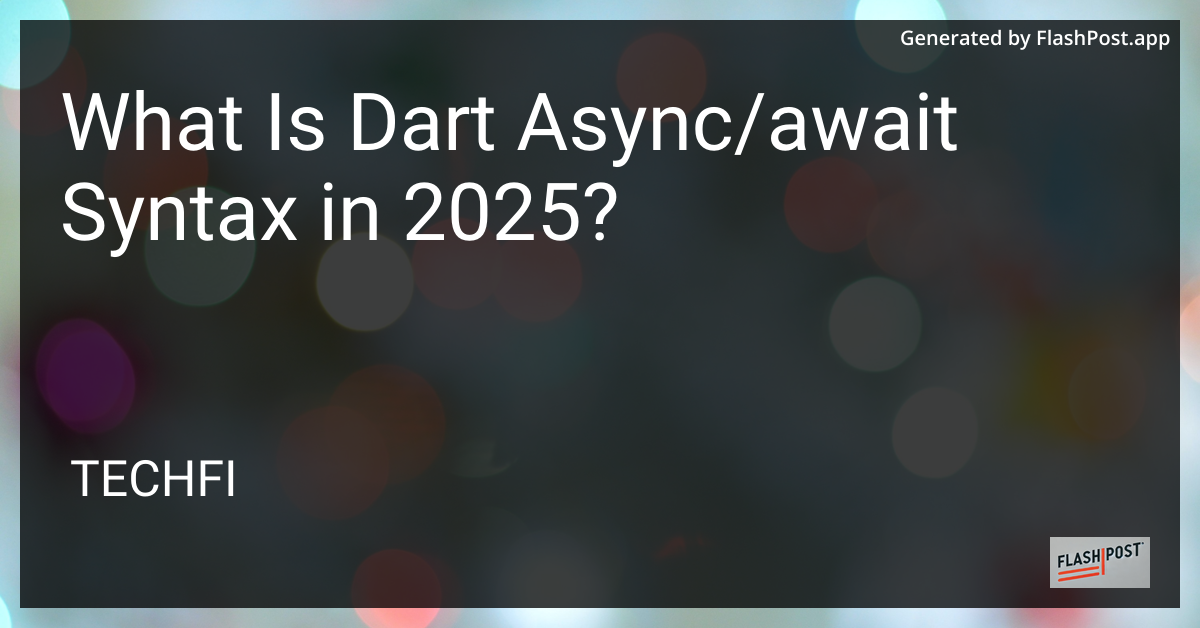What Is Dart Async/await Syntax in 2025?

Best Dart Programming Books to Buy in 2025
| Product | Features | Price |
|---|---|---|
 Flutter Design Patterns and Best Practices: Build scalable, maintainable, and production-ready apps using effective architectural principles |
Order Today  |
|
 Flutter and Dart Cookbook: Developing Full-Stack Applications for the Cloud |
Order Today  |
|
 Ultimate Flutter Handbook: Learn Cross-Platform App Development with Visually Stunning UIs and Real-World Projects (English Edition) |
Order Today  |
|
 Dart Programming, In 8 Hours, For Beginners, Learn Coding Fast: Dart Language Crash Course Textbook & Exercises (Cookbooks in 8 Hours 3) |
Order Today  |
|
 Dart Programming, In 8 Hours, For Beginners, Learn Coding Fast: Dart Programming Language, Crash Course Tutorial, Quick Start Guide & Exercises |
Order Today  |
In the rapidly evolving landscape of programming languages, Dart has positioned itself as a robust tool for developing scalable web and mobile applications. As we venture into 2025, understanding Dart's async/await syntax remains crucial for developers seeking to write efficient and readable asynchronous code. In this comprehensive guide, we'll delve into what async/await in Dart entails and how it transforms asynchronous operations into more manageable code blocks.
What is Dart?
Before diving into async/await syntax, it’s essential to understand Dart's fundamental role. Dart, an open-source programming language, was created by Google and is extensively used with Flutter, a UI toolkit for building natively compiled applications. Dart's primary goal is to offer developers a structured yet flexible language that simplifies the development of modern apps.
The Importance of Async/Await in Dart
Async/await simplifies the execution of asynchronous programming, which is critical in today's app development landscape. Asynchronous programming allows code to execute without blocking other operations, providing a seamless user experience by maintaining a responsive system. Dart's async/await syntax offers an elegant solution to manage asynchronous operations.
Benefits of Using Async/Await
- Cleaner Syntax: Async/await leads to code that is easier to read and write, resembling synchronous programming.
- Error Handling: Exception handling becomes straightforward with the use of try-catch blocks.
- Debugging: Troubleshooting becomes less complex compared to traditional callback-based code structures.
How Does Async/Await Work in Dart?
To leverage async/await in Dart, you need to understand two primary components: Future and await. Here’s a simplistic explanation:
Future: Represents a potential value or error that will be available at some time in the future. It is a core class enabling Dart's asynchronous operations.
Async and Await Keywords:
- Async: This keyword informs Dart that the function is asynchronous and may not return a value immediately.
- Await: Used before a future to halt the execution within an async function until the future completes.
Example Code
Here is a simple example of async/await being used:
Future<void> fetchData() async {
try {
String data = await fetchFromServer();
print('Data received: $data');
} catch (e) {
print('An error occurred: $e');
}
}
In the code above, fetchData is an asynchronous function that fetches data from a server. The await keyword ensures the operation completes before moving to the next line, providing a more synchronous flow construct.
Conclusion
As we continue through 2025, mastery of Dart's async/await syntax is imperative for developers aiming to create highly efficient applications. By employing these tools in simplifying asynchronous code, you can enhance your app’s performance and maintainability. For further programming insights and coding tips, explore these resources:
By continuously refining your understanding of asynchronous programming in Dart, you can remain at the forefront of modern application development. ```
This article is structured to provide comprehensive insights into Dart's async/await syntax, suitable for developers keen on enhancing their programming skills in 2025. The inclusion of external links adds further value by directing readers to additional learning resources.